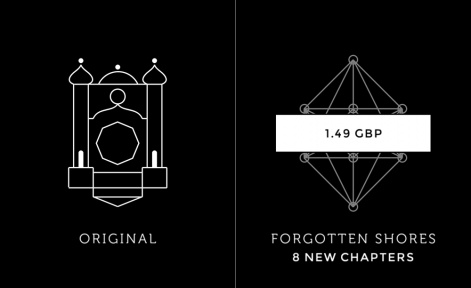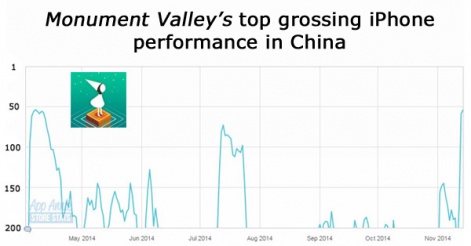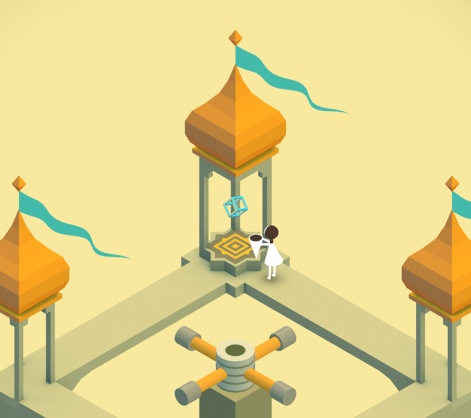Last week saw ustwo release eight extra levels for the much-acclaimed Monument Valley for £1.49/$1.99.
In the hours following its release, the game was hit by a rush of 1-star user reviews, with many games claiming they shouldn't have to pay for extra levels in a game they'd already paid out for.
There was then a sustained online campaign by some journalists, developers and gamers to get the game's user score back up again, which appeared to work.
So, we asked our Mavens:
Are gamers right to be put out for paying for new levels in a game they already paid for, or is it only right that developers be paid for fresh content?
Additionally, if the eight levels in Forgotten Shores had been released as a bonafide standalone sequel, would there have been any furore at all?
The grossing ranks of Monument Valley have only gone up since the release of the update.

This means the combination of new IAP and visibility worked to an overall positive effect.
Therefore the real story is that a paid game added extra content that people are still willing to pay for, not that a vocal minority is feeling unhappy.

A games programmer before joining Sony’s early PlayStation team in 1994, he then founded developer Pure Entertainment, which IPO’d and launched a free-to-play online gaming service way back in 1999.
He was also a director of pioneering motion gaming startup In2Games, which was sold to a US group in 2008.
Along the way, he’s been a corporate VP, troubleshooter, and non-exec to a variety of companies and investors in and around the games sector.
Harry was European CEO of Marvelous AQL, a Japanese developer and publisher of social, mobile and console games, known for console games like No More Heroes and Harvest Moon, but now highly successful in the free-to-play mobile and web space in Japan and Asia.
Harry is CEO of Magicave.
A gamer is no more entitled to free new content on Monument Valley than I am to infinite free coffee from Starbucks. It was one of the best games of the last year, and, frankly, anyone who didn't think it offered fantastic value for money shouldn't be buying games at all, because they're always going to be unhappy and games are supposed to be fun.
The best things in life always leave you wanting more; Monument Valley did just that and still managed to leave me delighted with what I'd had. It was a whole product. Had it ended abruptly with a 'to be continued...' (the movie Back to the Future II springs to mind) maybe there'd be a cause for upset, but it didn't.
That said, there's no real point complaining about the price erosion that happens due to digital distribution - it just 'is', Pandora's box is open and we can't do a lot to change it. We'll see the same thing happen on Steam over the coming year or so as the number of titles goes up, along with the size of the price cuts in the sales and bundles.
We saw it too in the retail console business, where the rise of pre-owned software made many single-player (hence short) games financially not viable. Steam and mobile have seen a lot of those dying genres given a new lease of life.

The fact that F2P has become so prevalent on mobile shows that requiring users to spend even trivial amounts of money is off-putting.Harry Holmwood
The fact that F2P has become so prevalent on mobile shows that requiring users to spend even trivial amounts of money is off-putting for most potential players - it's not about the price, it's about the principle of paying anything instead of nothing. That's fine - the people who want to pay up front for games are still out there, and still paying for the games they love. The people who don't want to pay for games weren't paying before mobile expanded the market.
I think we're only half way through the revolution that digital distribution (and variable pricing) is bringing to content creators.
In time, we'll see paying for gaming, whether up-front, through subscriptions or via IAP, become much more broadly accepted by users. It's happened with music, TV and film - where piracy a few years ago seemed to signal their doom, services like Netflix, Amazon Prime Video, Spotify and others are now becoming the mainstream way to consume and pay for content.
As with the Gamergate discussion a couple of weeks ago, it's an aspect of our connected world that unhappy (or faux-unhappy) voices can be heard loudly through social media, comments and reviews. I daresay it's a tiny percentage of Monument Valley's million-plus audience that's complaining - the rest of us are delighted to spend a few pennies for a bit more of a game we loved, and I hope it hasn't disheartened the developers too much to see the negativity of a few take centre stage for a day or so.
I've never trusted the vocal minority. Let's see what the stats say...
Looking at the historical download ranks on App Annie, Monument Valley (now at 4th in the Paid US Games charts on iPhone) was at 50th just three days ago. It is at 3rd in the iPad charts. Think the daily revenue comes in at around $23,000 (US only) but I think that must be a few days out of date as the installs seem to be at 24,000/day right now so it should be grossing nearly $100,000 a day if those install rates are correct.

From a cursory look, it is the same picture in the UK, Canada and most other countries. What's perhaps more interesting is that its grossing ranks seems to have climbed even more than its install ranks. I can't see if there were any price drops/promotions previously but if their ARPU (which is all users as this is a premium game) is on the rise then clearly a decent percentage of players (previous and new) are now paying for the extra content.
So, installs are up (in all major markets) and average revenue per user is also up. Seems to me like most people like the game and don’t mind paying more for extra content.
I put this down to the inevitable growing pains of the industry as it works out how best to utilise the various payment models.Kevin Corti
Being picky, perhaps ustwo could have handled it a tad more delicately, perhaps by giving existing users some content for free, but I really don't think it is an issue. Philosophically, I guess the initial complaints highlights that transparency of pricing is important in maintaining good customer relations.
We're all trained to expect that 'free' = optional IAPs and premium gives you "all you can eat" so it's not unexpected that some people feel that they have been conned but judging by the game's great performance in the charts, it is really only a few people. Most people, I suspect, will simply take the viewpoint that they knew what they were buying the first time around and now the developer has offered them some more content if they want it.
I put this down to the inevitable growing pains of the industry as it works out how best to utilise the various payment models.
It would be cool if ustwo would tell us what percentage of existing users are taking up the extra content!
Harry, whilst I agree people aren't entitled to more free content, your coffee analogy is broken. Each cup has an associated fixed cost for the beans and staffing, whereas a digital product once created can be distributed infinity for free. It's not the same and consumers know that.
Besides, Starbucks has a free refill policy, which is what people are really asking for.
I think the content should have been launched as a stand alone 'episode'.Will Luton
I worry about the prevalence in the mobile industry of blaming consumers for expecting free and calling it a "price erosion". I would posit that free has lead to increased revenues overall and consumers are (generally) happier for it. The paid model can still work, just at a different scale than free does.
I think the content should have been launched either for free as part of a wider marketing push on the app or as a stand alone "episode". Launching it as paid inside the app is relatively hidden as you can only push to your Daily Active Users and I expect conversion would be low.
It's worth noting that Monument Valley has a solid App Store feature (Best New Game Updates) right now, accounting for the increased installs.
Kevin, do the paid charts and grossing scale linearly? Don't know if I follow the logic that ARPU has increased on that basis. Because Monument Valley has a higher price point than most it rises up the grossing chart relative to its paid chart position quicker than a 99c game would. I don't think you can derive ARPU changes that way, unless I'm missing something?
Sir Luton is right. I wasn't paying close enough attention. As we say in Lestersherstershire, that will learn me!
Someone ask Mills what the conversion rate is. That will pretty much end the debate one way or another.

A games programmer before joining Sony’s early PlayStation team in 1994, he then founded developer Pure Entertainment, which IPO’d and launched a free-to-play online gaming service way back in 1999.
He was also a director of pioneering motion gaming startup In2Games, which was sold to a US group in 2008.
Along the way, he’s been a corporate VP, troubleshooter, and non-exec to a variety of companies and investors in and around the games sector.
Harry was European CEO of Marvelous AQL, a Japanese developer and publisher of social, mobile and console games, known for console games like No More Heroes and Harvest Moon, but now highly successful in the free-to-play mobile and web space in Japan and Asia.
Harry is CEO of Magicave.
Will - I don't think the coffee analogy is broken. Yes the digital content can be replicated ad infinitum, but there is a fixed cost of making that new content. Expecting new levels is not the same as a coffee refill. It's like buying a coffee then expecting a free pastry. Six months later.

I do completely agree though that blaming customers and worrying about 'price erosion' is pointless. The key is to make products that enough customers will pay for (regardless of F2P or premium model) to make it viable. Which I think is exactly what ustwo did with Monument Valley.
I think charging for new levels is far less exploitive than the "pay to win" model of many Skinner Box IAP cash generating engines. This is a IAP model that people should be happy about and support.
Disclaimer: We created the puzzle game, Crickler, which uses puzzle credits (an IAP purchase) that players expend when they load in new word puzzles.
Dropping in here a little bit guys.
It's been amazing to see the reaction from our own fanbase.Dan Gray
Let's just say this whole thing is a bit of a storm in a teacup and the one star issue lasted around 30 minutes before everyone jumped on board and bumped it back to its past rating of 4.5 - 5.0 stars worldwide. It's been amazing to see the reaction from our own fanbase and how strongly they feel about supporting this kind of game in the marketplace.
It did act as a catalyst to a wider discussion on player expectation and value though, which is always a good thing.
The main thing we as developers can do is bring people content so beautiful and well crafted that the quality difference between spending $2 on 500 coins and $2 of content for your premium game is a no brainer.
So far the data suggests that we managed that.
It’s completely unfair to say their top grossing achievement is due to them having a promo spot in the Best New Game Updates category. I would love if anyone could point out any other game in that category that was able to jump into top 100 grossing based on an update and that promo alone.
Also the cup of coffee versus digital analogy makes sense if the numbers for digital are several multiples more than their physical counterparts but at the end of the day you need to compare profit vs loss and the initial production costs for digital far outweigh the equivalent cost of designing a new coffee product.
These Monument Valley levels are not cheap to make. On the surface they don’t seem like a lot but there is huge attention to detail and love put into them. Also the levels themselves are much more ambitious that the ones in the original game. It’s easy to say that ustwo should have given away some levels for free to somehow offset the paid ones but with only 8 new levels released. They would have had to delay their update and miss the holidays or reduce the number of levels in the paid pack.
It’s easy to armchair quarterback but I think ustwo made a sensible choice given that they didn’t know in advance how well the new update would sell.

That said, I think it would be interesting to discuss how these things are presented vs. the expectations of our customers. Not all paid updates get complainers. The Walking Dead, The Room, even Candy Crush have paid level expansions and virtually no complainers. Is it a matter of training your users by offering a paid expansion in the initial release? Calling them episodes? Does it seem like Monument Valley’s levels are so much cheaper to make compared to The Room or does it just attract a different audience that is much more entitled?
It’s a really difficult problem to communicate actual value to end consumers. In one of our past games we took a lot of heat for charging 99c for a new theme to our game that took four weeks to create versus other games seem to be fine selling a single bitmap for $10. Many customers don’t understand the amount of effort that goes into good game design, as is the case with Monument Valley.
Monument Valley is a great game, one that couldn’t exist with a freemium model.Dave Castlenuovo
Sure they could have knocked out another 8 levels that were cheap to build and given them away for free but no one would appreciate them and it would set up an expectation that the paid levels were probably more of the same.
Monument Valley is a great game, one that couldn’t exist with a freemium model. This doesn’t take away from successful freemium games or the freemium model itself but we need more developers to take chances making games like Monument Valley.
As an industry we need for them to be successful. Diversity is the key to long term growth and when you are in a situation where everyone feels like they need to clone a single business model to succeed you run the risk of the entire ecosystem becoming stagnant. Already the freemium model is being subsidised by huge user acquisition spending while paid gems like Monument Valley and threes find equivalent levels of success without spending a dime. The fact that these games can show up in the top grossing charts despite all the noise shows that there is a market.
Paid has an underserved audience and paid games have a lot less overhead in out-of-pocket user acquisition expenses and in the manpower necessary to analyse and manage the economy and tweak the game to get users to monetize. Especially for small teams, this seems like an attractive place to be.

Oscar Clark has been a pioneer in online, mobile, and console social games services since 1998. He is also author of the book, Games As A Service – How Free To Play Design Can Make Better Games.
First let's be clear, I think Monument Valley is a triumph, a delightful puzzle that I am glad to see more content for. However, it's not my favourite game. I think games are different from puzzles, but that's an esoteric point I know.
Lots of players complained when they released more levels. They gave the game 1 star reviews because they, as an audience, had an expectation set by considerable precedent that games they "buy" upfront should mean they don't keep paying.
Is this reasonable? If you take the "cup of coffee" argument it's obviously not. However, economics and human responses are demonstrably not simplified "common sense" arguments. The expectations that these players could compare with is set in other games regardless of the effort to make that content. It's not about "what's it worth" it's about "what the audience will pay for".
The natural state of any customer is not to spend. We have to create anticipation.Oscar Clark
The problem is one of communication to an audience. Many players (including myself) will have been delighted to find that there are new levels. However, that doesn't mean the release was well handled.
The natural state of any customer is not to spend. We have to create anticipation, demonstrate a reason to act now, offset concerns over opportunity costs and create a positive social context in which the transaction takes place.
That's what retail requires us to do whether it's the initial sale (or download of a game) or in app purchases.
Please also be clear that I'm not attacking ustwo either. The rating system has become the go-to communication system for a certain type of dedicated player. We need better more two way communication routes so they can let us know what they like and dislike before "punishing" the game. But if we think this will magically stop happening and players will suddenly play nice we are fooling ourselves.
The rating system can and therefore will be abused by players for whom it has little personal consequence; but for developers it has a measurable impact on our sustainability.
For me I think ustwo could have taken a different approach to the release of content; but the approach they took was a well trodden road. What they didn't know is that the ongoing F2P storm had left gigantic potholes for them to fall into.

I think in the end the quality of their work will shine through, but it is a sound reminder that we are not just here to make great art but to entertain our audience.
They can be fickle, entitled, vengeful even, but we are asking them to part with their cash for our content amongst an infinite alternative supply.
If we take time and respond to their needs, deliver quality and engage their interest - perhaps even create some social capital we may just find that they can also be hugely loyal, supportive and a source of inspiration.
Just want to say that the whole one star thing was blown out of proportion. There wasn't actually any significant backlash to the way things were priced, released or handled and the "problem" has just been propagated online as it's simply an interesting story.
It's actually been an astronomically good release, both in terms of downloads and exposure and a massive majority of players are overjoyed with the offering and have upgraded. We've probably had more people on Twitter asking for ways to give us more money than we have people complaining about the price.
Storm in a teacup stuff, this.
[people id="11" name="Brian Baglow"]
There's a Maven's column. The role of the games media in the ongoing evolution of the market.[/person]




























